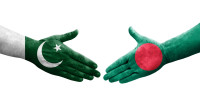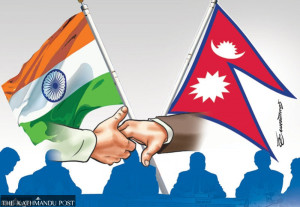Columns
Women face unequal vulnerabilities during disasters
The phenomenon of male out-migration alters how women are affected during natural catastrophes..jpg&w=900&height=601)
Shristi Shakya
‘I spend sleepless nights anticipating floods every monsoon,’ exclaimed a woman who lives with her ailing father-in-law and two children near Lothar Khola in Chitwan. Her husband is a foreign labour migrant, and the responsibility of getting the family to safety would be hers if there is a flood. ‘Without men to rescue us, we would die,’ said another woman. She, like many members of the community, believe that women are primarily dependent upon men, and are more vulnerable and affected during disaster events, especially the ones that suddenly occur—like floods.
Water-induced disasters are one of the most recurrent, predictable, yet devastating phenomena that adversely impact the lives and livelihood of many riverine communities in Nepal. According to the UN Development Programme’s Global Assessment of Risk report, Nepal ranks 30th in the world in flood hazard risk. The Ministry of Home Affairs reported 159 incidents of floods and 302 incidents of landslides between April 14 and August 11 this year, resulting in 121 deaths, 36 people missing and 73 cases of injuries. About 41 percent of the casualties reported were females. In instances of such disasters, the section of the society that is oftentimes the most affected are the women, children, and the elderly. This differentiated vulnerability within population segments, however, does not result solely from the occurrence of disasters. They are largely shaped by a multitude of socio-cultural, political and economic factors that shape social interaction and processes.
The phenomenon of male out-migration is rapidly changing the social demography of Nepali society. The Ministry of Labour and Employment’s status report on work-related migration for the fiscal years 2015-16 and 2016-17, showed that a total of 362,766 male Nepalis obtained labour permits to work abroad in the year 2017. This accounts for 94.75 percent of the total number of permits issued that year. Able-bodied men are leaving in droves, and those left behind are compelled to adjust to the new complex social realities. This process of male out-migration has exacerbated the disaster vulnerability of those left behind. Men are traditionally seen taking leading roles and making vital decisions from rescue to recovery, and as such, the manifestation of hazards can become an ordeal for those left behind.
Further, gender roles backed by patriarchal norms and cultural practices render women vulnerable to disasters. Take, for instance, the dress they wear, such as lungi, nightgown (maxi) or sari, which when soggy, can make mobility and the rescue process difficult. Getting uncomfortable stares while the clothes stick to their bodies, that too in a relief camp, is another experience that women go through. Likewise, they cannot ignore childcare and other household chores like cooking and cleaning no matter where they take refuge, be it in a communal shelter, at a relative’s house or a relief camp. This means collecting firewood, managing cooking utensils, collecting clean drinking water as well as ensuring the family members are fed and warm, despite the shortage of resources in such adversity.
Women’s limited access to, and ownership of, assets also tend to aggravate their vulnerability to disaster. Fewer social ties and lack of participation in social groups, for example, limits access to disaster early warning information as well as much needed hard labour and emotional support during disasters. Women also lack education, training, skills, and knowledge on preparedness, rescue and rebuilding, hence have to depend upon others. Similarly, the lack of savings and the inability to make decisions regarding mobilising financial resources also affects them during disasters. Further, women tend to have a strong sense of attachment to their material possessions. Leaving everything behind—especially core assets like their cattle, harvest, kitchen materials etc.—is a traumatising experience. A 65-year-old woman from Shantinagar, Hetauda recalled not caring about anything else other than her roosters and cattle feed while she waited for the waters to recede in the 2017 floods that affected the whole of the Tarai. In fact, the loss of these belongings and the lack of social, financial and human capital affect their ability to recover from the disaster as well.
These impacts can further be manifested in various forms. Loss of family members and household possessions or the disaster experience itself can lead to psychological trauma, emotional turmoil and stress. It can also result in diminishing assets and increased poverty. This, in turn, compounds to the continuation of the vicious cycle of disaster vulnerability.
Despite these challenges, it is crucial to realise that women are not mere victims of disasters. Instead, they are potent agents to build resilience to disasters in their communities. That is why women should be trained and mobilised in both formal and informal disaster management in their communities. Women’s capacities must be channelled for gender-responsive and inclusionary disaster management. The Disaster Risk Reduction and Management Act 2017 and the National Policy for Disaster Risk Reduction 2018 do emphasise on effective planning and implementation of strategies focusing on women, children, elderly, Dalit and the marginalised at risk. They also provide for these segments to have better access, greater representation and more meaningful participation in federal, provincial and local level disaster risk reduction and management initiatives. Despite such provisions, adoption and implementation of these policies in all of the 753 local units have proved challenging. Community-level disaster management has not yet seeped into all local groups. As such, women and vulnerable groups continue to be disproportionately affected by disasters.
The monsoon in Nepal this year is almost over. As the water recedes, so does the attention on water-induced disasters. Both communities and the government tend to forget the inherent risks posed by floods. But the monsoon will return again in nine months, and if communities are not prepared, they will again have to suffer losses, like every monsoon. Preparedness is one of the critical factors that determine both the vulnerability and resilience of communities to disaster events. However, progress towards this end has remained far from satisfactory. The focus continues to centre around rescue and relief.
Local governments, with their role and mandate in disaster planning and management, have an excellent opportunity to demonstrate success in instituting an inclusive and context-sensitive localised strategy for preparedness and response. The way forward is to engage and empower communities at risk in local disaster planning processes. This shall ensure that the plans and strategies formulated demonstrate an appreciation of the differentiated vulnerabilities, as well as empower local knowledge and expertise for enhanced resilience.




 10.12°C Kathmandu
10.12°C Kathmandu.jpg)















